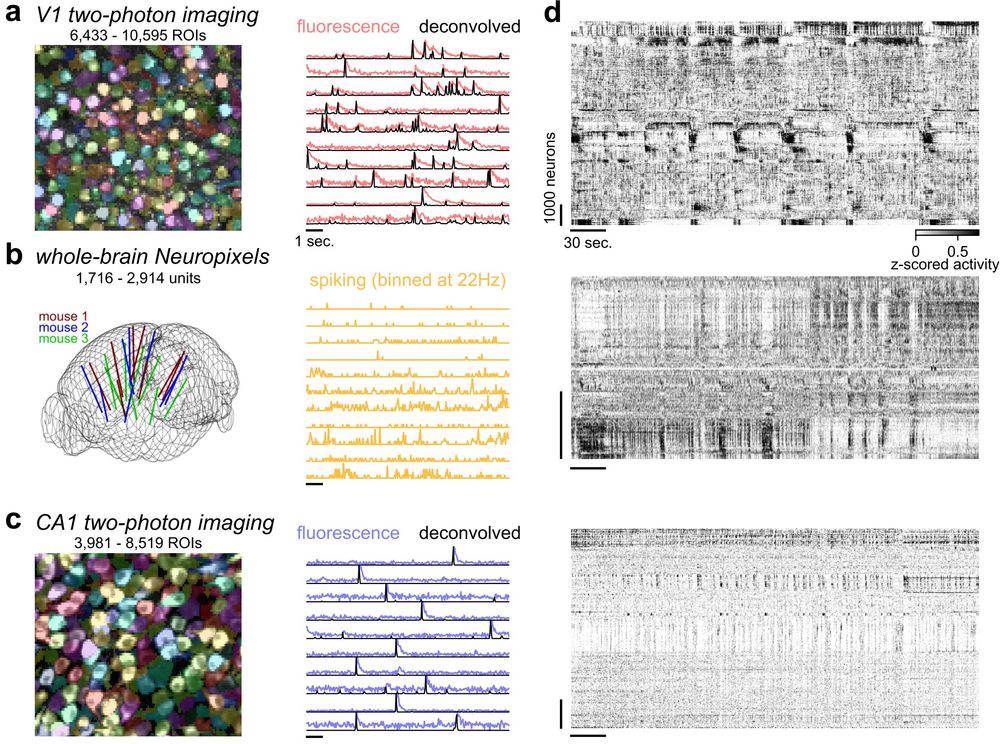Slate status: not blank
25.11.2025 08:12 — 👍 23 🔁 2 💬 3 📌 2Tal Sharf
@talsharf.bsky.social
sharflab.ucsc.edu
@talsharf.bsky.social
sharflab.ucsc.edu
Slate status: not blank
25.11.2025 08:12 — 👍 23 🔁 2 💬 3 📌 2Many thanks to Tjitse van der Molen, Alex Spaeth, @mattiachini.bsky.social and all the amazing collaborators who made this work possible.
25.11.2025 02:04 — 👍 1 🔁 0 💬 0 📌 0Our findings support the idea that preconfigured temporal structure is an intrinsic, emergent property of neurodevelopment that is established even before sensory input.
25.11.2025 02:04 — 👍 0 🔁 0 💬 1 📌 0Using high-density, large-scale neurophysiology recordings from organoids, we model early dynamics of early human brain development. We complement these data with matching neonatal mouse cortical recordings to examine the temporal firing patterns that emerge during early circuit assembly.
25.11.2025 02:04 — 👍 1 🔁 0 💬 1 📌 0
I was told it would take about three years to get a new lab up and running. Nearly three years later, our work on preconfigured neuronal firing sequences in human brain organoids is finally out in Nature Neuroscience: www.nature.com/articles/s41...
25.11.2025 02:04 — 👍 6 🔁 0 💬 1 📌 1
"We can, should, and will use cerebral organoids to discover new medical treatments, study brain development, reduce the demand for animal testing, and even power computers and more energy-efficient AI."
www.vox.com/future-perfe...

In an NSF-supported study, @talsharf.bsky.social and collaborators will investigate the capacity of human brain organoids to learn and adapt, with implications for #organoid research, #bioethics, and science education.
news.ucsc.edu/2025/10/lear...

schematic of neural recordings from mouse V1, whole-brain, and hippocampus; neural activity traces from the population, showing more correlated activity in V1 and whole-brain recordings versus more decorrelated activity in hippocampus
What if… spontaneous neural activity 🧠 reflects the baseline rumblings of a brainwide dynamical system initialized for learning? We find that the rumblings have macroscopic properties like those emerging from linear symmetric, critical systems 🧵 #neuroscience #neuroAI www.biorxiv.org/content/10.1...
12.01.2025 19:55 — 👍 304 🔁 82 💬 9 📌 0
Awesome work by @mrbadash.bsky.social and the crew at @ucscgenomics.bsky.social
Goal-directed learning in cortical #organoids
www.biorxiv.org/content/10.1...
Our manuscript preprint is out!
17.01.2025 09:15 — 👍 1 🔁 2 💬 0 📌 0Our work demonstrates that the emergence of intrinsic computational architectures, defined by low- and high-dimensional activity patterns and neuronal sequences, is an emergent property of neuronal self-assembly and achievable in brain organoid models.
09.01.2025 19:26 — 👍 1 🔁 0 💬 0 📌 0Phenomena such as "preplay," pre-existing sequence motifs are thought to encode novel experiences and underlie episodic memory retrieval in the human cortex. These motifs have recently been shown to encode non-redundant information beyond latency and rate encoding.
09.01.2025 19:26 — 👍 0 🔁 0 💬 1 📌 0The use of neuronal sequences to encode sensory input and motor output has been widely studied. However, whether these sequences arise innately through neurogenesis and synaptogenesis (nature) or emerge through sequential experience (nurture) remains unresolved.
09.01.2025 19:26 — 👍 0 🔁 0 💬 1 📌 0This conclusion can be made most powerfully in a brain organoid that does not have the intimate developmental interaction with other organ systems and thus excludes an internal setting due to cardiac signals, for example, of brain rhythms.
09.01.2025 19:26 — 👍 0 🔁 0 💬 1 📌 0Employing human and murine brain organoids alongside ex vivo neonatal murine brain slices, we demonstrate that intrinsic neuronal sequences, which delineate low- and high-dimensional latent subspaces for information encoding, emerge independently of sensory experience.
09.01.2025 19:26 — 👍 0 🔁 0 💬 1 📌 0In our updated manuscript we present strong evidence supporting the pre-configured brain hypothesis. Separating the effects of experience from intrinsic network dynamics has historically been challenging due to experimental limitations.
09.01.2025 19:26 — 👍 0 🔁 0 💬 1 📌 0
I’m thrilled to share our revised work on neuronal sequences in brain #organoids. It has been an absolute joy to collaborate with an incredible team of talented experimental and computational neuroscientists brought together by this project. www.biorxiv.org/content/10.1...
09.01.2025 19:26 — 👍 3 🔁 1 💬 1 📌 0